Green Management in Sustainability Management Report Analysis
VerifiedAdded on 2020/05/04
|12
|2916
|78
Report
AI Summary
This report provides an in-depth analysis of green management and sustainability practices, focusing on the case of Fujitsu in Singapore. It examines Fujitsu's green procurement processes, including environmental management systems and supplier evaluation. The report identifies key elements of Fujitsu's green procurement and assesses their maturity levels, along with the associated risks and benefits. Furthermore, it delves into Fujitsu's sustainability report, highlighting its compliance with Sustainability Accounting Standards Board (SASB) guidelines and its efforts to reduce CO2 emissions and promote biodiversity. The report also addresses the severity of e-waste in Singapore, discussing the challenges and potential solutions, particularly the importance of recycling. Finally, it explores the issue of greenwashing, providing an example of a company's marketing and communication plan and offering recommendations for effective promotion of green initiatives. This report serves as a comprehensive resource for understanding the complexities of green management, sustainability, and environmental responsibility in the business context.
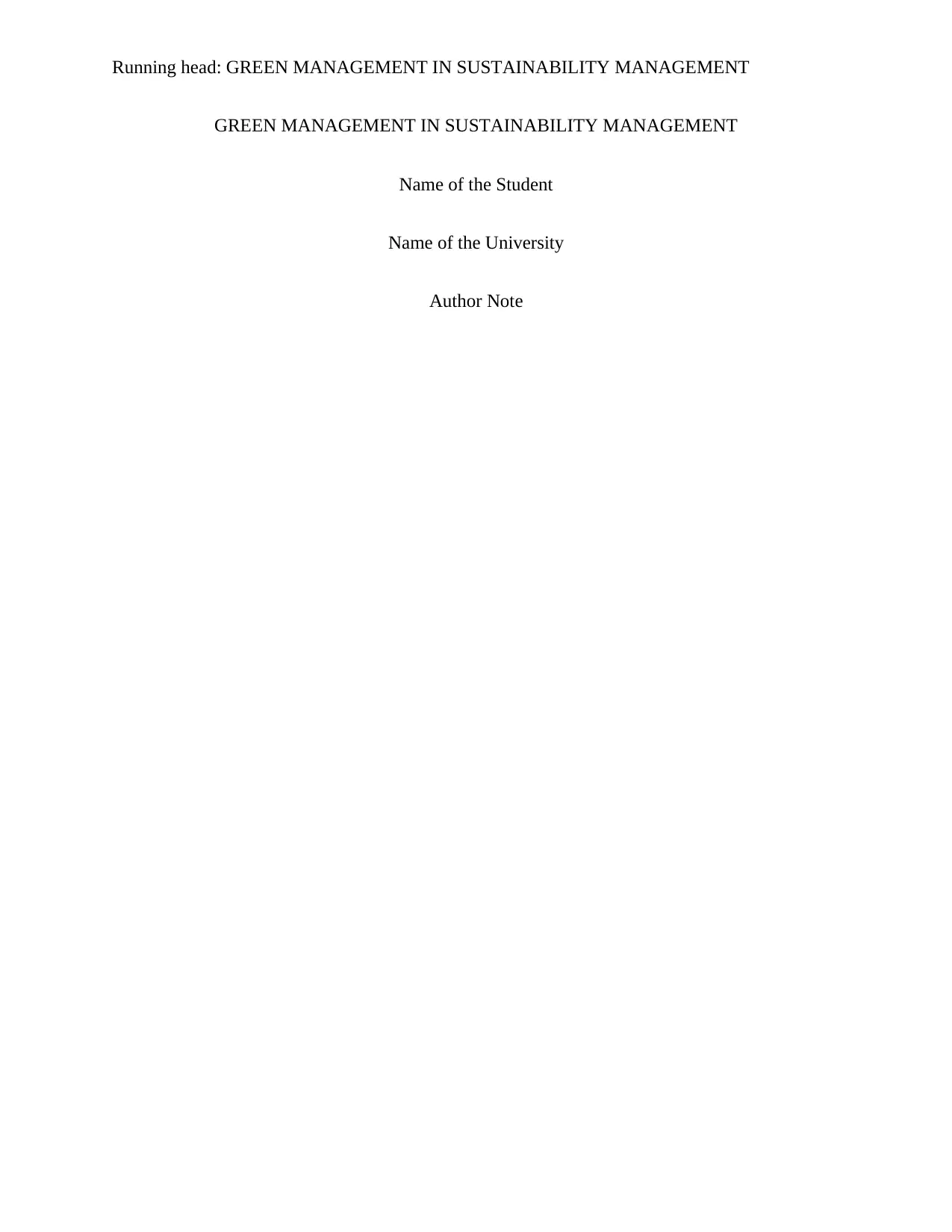
Running head: GREEN MANAGEMENT IN SUSTAINABILITY MANAGEMENT
GREEN MANAGEMENT IN SUSTAINABILITY MANAGEMENT
Name of the Student
Name of the University
Author Note
GREEN MANAGEMENT IN SUSTAINABILITY MANAGEMENT
Name of the Student
Name of the University
Author Note
Paraphrase This Document
Need a fresh take? Get an instant paraphrase of this document with our AI Paraphraser
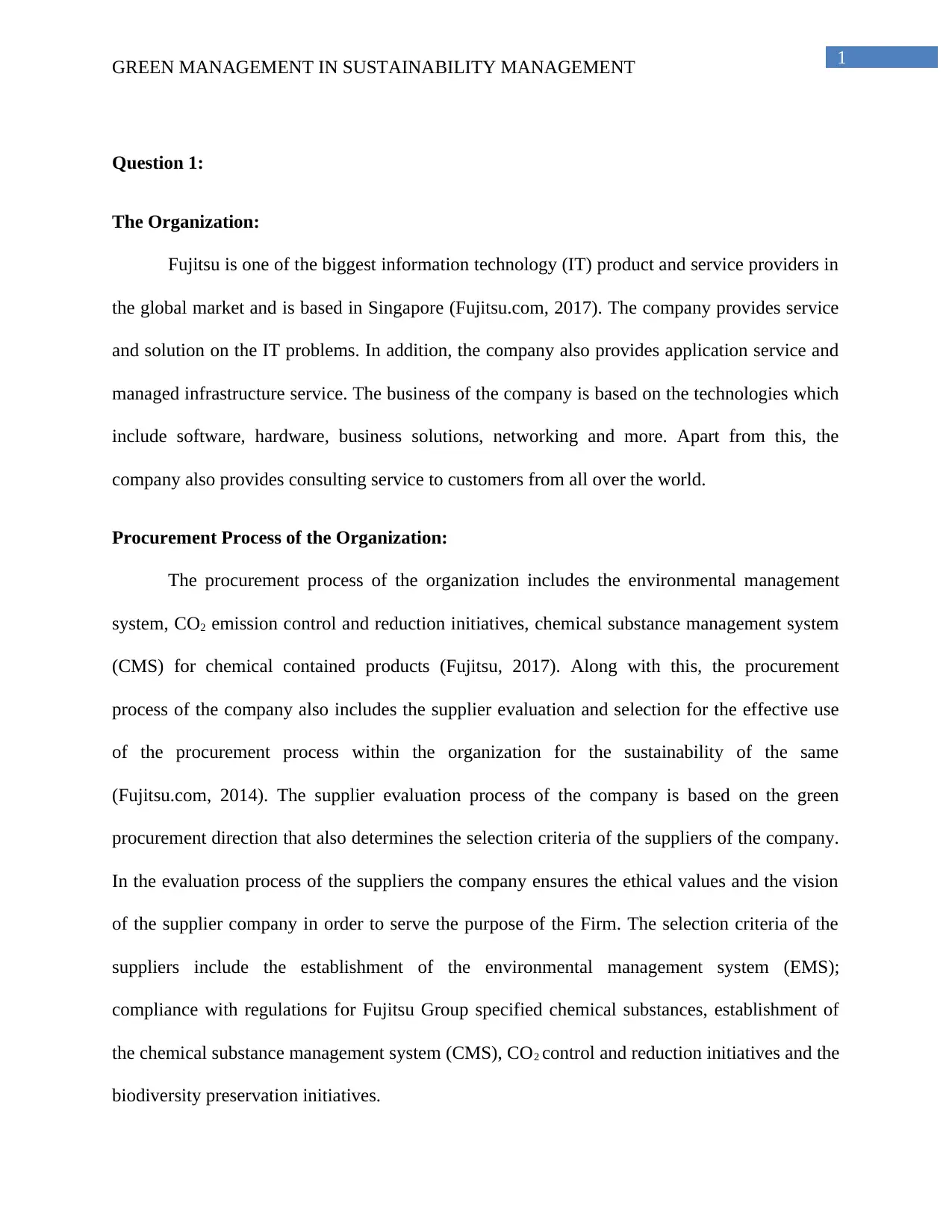
1
GREEN MANAGEMENT IN SUSTAINABILITY MANAGEMENT
Question 1:
The Organization:
Fujitsu is one of the biggest information technology (IT) product and service providers in
the global market and is based in Singapore (Fujitsu.com, 2017). The company provides service
and solution on the IT problems. In addition, the company also provides application service and
managed infrastructure service. The business of the company is based on the technologies which
include software, hardware, business solutions, networking and more. Apart from this, the
company also provides consulting service to customers from all over the world.
Procurement Process of the Organization:
The procurement process of the organization includes the environmental management
system, CO2 emission control and reduction initiatives, chemical substance management system
(CMS) for chemical contained products (Fujitsu, 2017). Along with this, the procurement
process of the company also includes the supplier evaluation and selection for the effective use
of the procurement process within the organization for the sustainability of the same
(Fujitsu.com, 2014). The supplier evaluation process of the company is based on the green
procurement direction that also determines the selection criteria of the suppliers of the company.
In the evaluation process of the suppliers the company ensures the ethical values and the vision
of the supplier company in order to serve the purpose of the Firm. The selection criteria of the
suppliers include the establishment of the environmental management system (EMS);
compliance with regulations for Fujitsu Group specified chemical substances, establishment of
the chemical substance management system (CMS), CO2 control and reduction initiatives and the
biodiversity preservation initiatives.
GREEN MANAGEMENT IN SUSTAINABILITY MANAGEMENT
Question 1:
The Organization:
Fujitsu is one of the biggest information technology (IT) product and service providers in
the global market and is based in Singapore (Fujitsu.com, 2017). The company provides service
and solution on the IT problems. In addition, the company also provides application service and
managed infrastructure service. The business of the company is based on the technologies which
include software, hardware, business solutions, networking and more. Apart from this, the
company also provides consulting service to customers from all over the world.
Procurement Process of the Organization:
The procurement process of the organization includes the environmental management
system, CO2 emission control and reduction initiatives, chemical substance management system
(CMS) for chemical contained products (Fujitsu, 2017). Along with this, the procurement
process of the company also includes the supplier evaluation and selection for the effective use
of the procurement process within the organization for the sustainability of the same
(Fujitsu.com, 2014). The supplier evaluation process of the company is based on the green
procurement direction that also determines the selection criteria of the suppliers of the company.
In the evaluation process of the suppliers the company ensures the ethical values and the vision
of the supplier company in order to serve the purpose of the Firm. The selection criteria of the
suppliers include the establishment of the environmental management system (EMS);
compliance with regulations for Fujitsu Group specified chemical substances, establishment of
the chemical substance management system (CMS), CO2 control and reduction initiatives and the
biodiversity preservation initiatives.
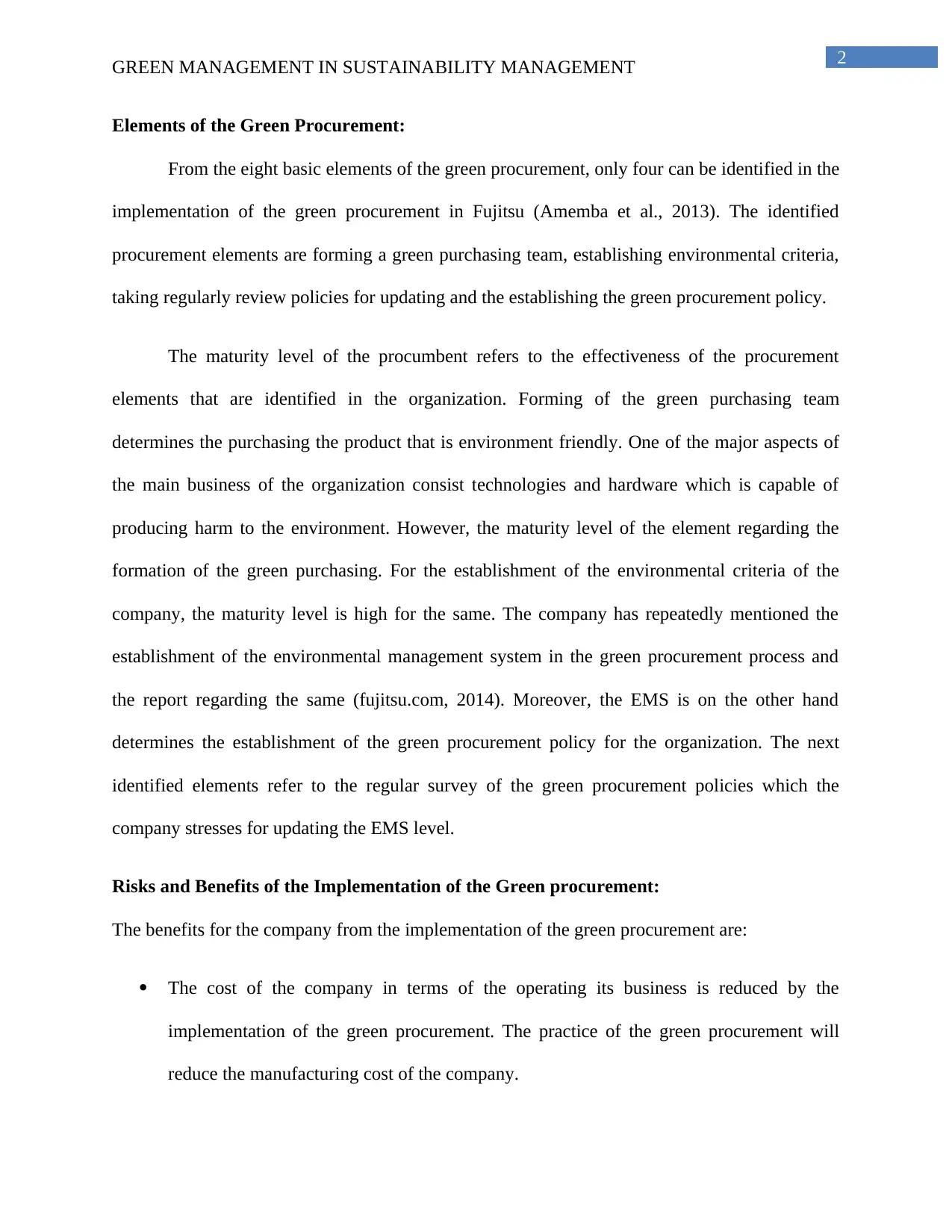
2
GREEN MANAGEMENT IN SUSTAINABILITY MANAGEMENT
Elements of the Green Procurement:
From the eight basic elements of the green procurement, only four can be identified in the
implementation of the green procurement in Fujitsu (Amemba et al., 2013). The identified
procurement elements are forming a green purchasing team, establishing environmental criteria,
taking regularly review policies for updating and the establishing the green procurement policy.
The maturity level of the procumbent refers to the effectiveness of the procurement
elements that are identified in the organization. Forming of the green purchasing team
determines the purchasing the product that is environment friendly. One of the major aspects of
the main business of the organization consist technologies and hardware which is capable of
producing harm to the environment. However, the maturity level of the element regarding the
formation of the green purchasing. For the establishment of the environmental criteria of the
company, the maturity level is high for the same. The company has repeatedly mentioned the
establishment of the environmental management system in the green procurement process and
the report regarding the same (fujitsu.com, 2014). Moreover, the EMS is on the other hand
determines the establishment of the green procurement policy for the organization. The next
identified elements refer to the regular survey of the green procurement policies which the
company stresses for updating the EMS level.
Risks and Benefits of the Implementation of the Green procurement:
The benefits for the company from the implementation of the green procurement are:
The cost of the company in terms of the operating its business is reduced by the
implementation of the green procurement. The practice of the green procurement will
reduce the manufacturing cost of the company.
GREEN MANAGEMENT IN SUSTAINABILITY MANAGEMENT
Elements of the Green Procurement:
From the eight basic elements of the green procurement, only four can be identified in the
implementation of the green procurement in Fujitsu (Amemba et al., 2013). The identified
procurement elements are forming a green purchasing team, establishing environmental criteria,
taking regularly review policies for updating and the establishing the green procurement policy.
The maturity level of the procumbent refers to the effectiveness of the procurement
elements that are identified in the organization. Forming of the green purchasing team
determines the purchasing the product that is environment friendly. One of the major aspects of
the main business of the organization consist technologies and hardware which is capable of
producing harm to the environment. However, the maturity level of the element regarding the
formation of the green purchasing. For the establishment of the environmental criteria of the
company, the maturity level is high for the same. The company has repeatedly mentioned the
establishment of the environmental management system in the green procurement process and
the report regarding the same (fujitsu.com, 2014). Moreover, the EMS is on the other hand
determines the establishment of the green procurement policy for the organization. The next
identified elements refer to the regular survey of the green procurement policies which the
company stresses for updating the EMS level.
Risks and Benefits of the Implementation of the Green procurement:
The benefits for the company from the implementation of the green procurement are:
The cost of the company in terms of the operating its business is reduced by the
implementation of the green procurement. The practice of the green procurement will
reduce the manufacturing cost of the company.
⊘ This is a preview!⊘
Do you want full access?
Subscribe today to unlock all pages.

Trusted by 1+ million students worldwide
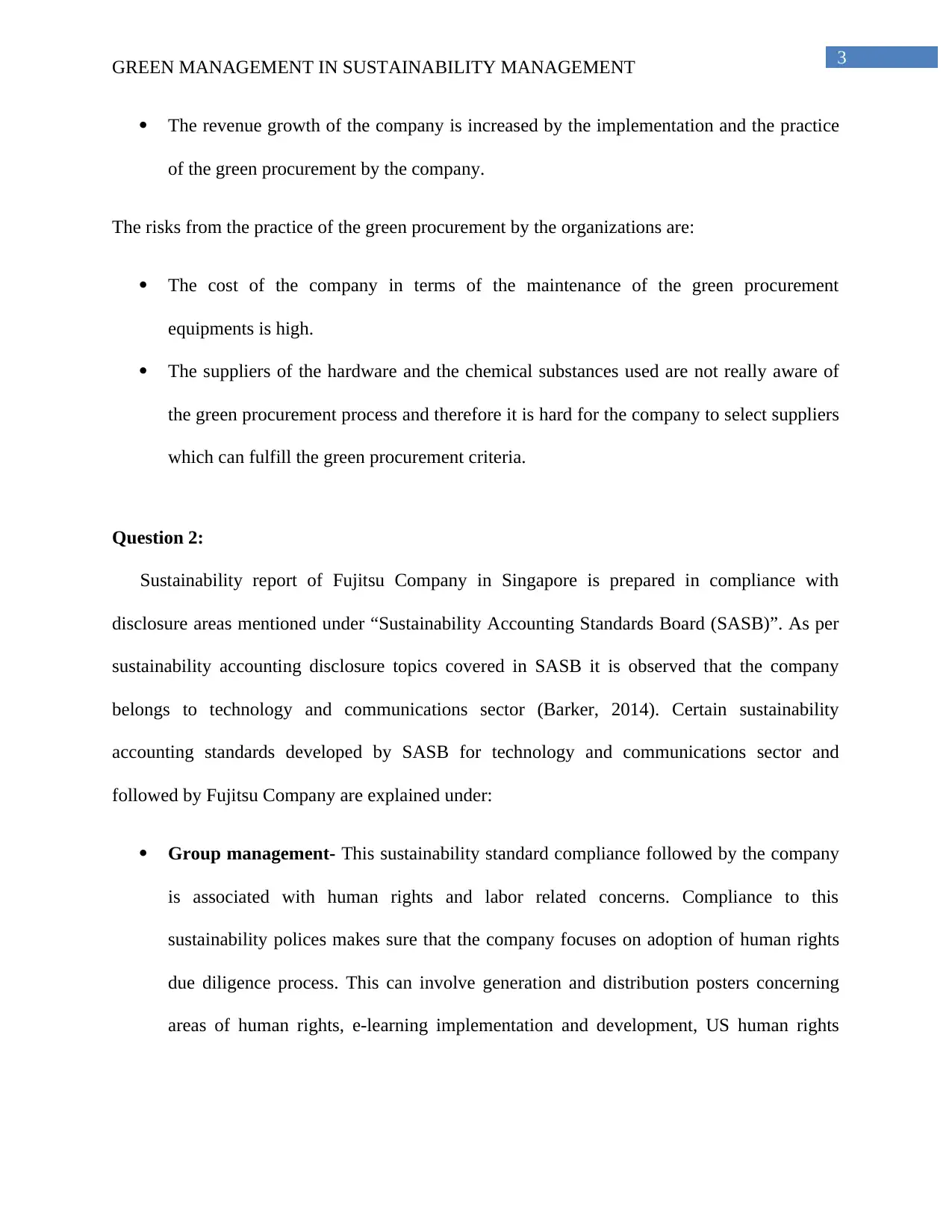
3
GREEN MANAGEMENT IN SUSTAINABILITY MANAGEMENT
The revenue growth of the company is increased by the implementation and the practice
of the green procurement by the company.
The risks from the practice of the green procurement by the organizations are:
The cost of the company in terms of the maintenance of the green procurement
equipments is high.
The suppliers of the hardware and the chemical substances used are not really aware of
the green procurement process and therefore it is hard for the company to select suppliers
which can fulfill the green procurement criteria.
Question 2:
Sustainability report of Fujitsu Company in Singapore is prepared in compliance with
disclosure areas mentioned under “Sustainability Accounting Standards Board (SASB)”. As per
sustainability accounting disclosure topics covered in SASB it is observed that the company
belongs to technology and communications sector (Barker, 2014). Certain sustainability
accounting standards developed by SASB for technology and communications sector and
followed by Fujitsu Company are explained under:
Group management- This sustainability standard compliance followed by the company
is associated with human rights and labor related concerns. Compliance to this
sustainability polices makes sure that the company focuses on adoption of human rights
due diligence process. This can involve generation and distribution posters concerning
areas of human rights, e-learning implementation and development, US human rights
GREEN MANAGEMENT IN SUSTAINABILITY MANAGEMENT
The revenue growth of the company is increased by the implementation and the practice
of the green procurement by the company.
The risks from the practice of the green procurement by the organizations are:
The cost of the company in terms of the maintenance of the green procurement
equipments is high.
The suppliers of the hardware and the chemical substances used are not really aware of
the green procurement process and therefore it is hard for the company to select suppliers
which can fulfill the green procurement criteria.
Question 2:
Sustainability report of Fujitsu Company in Singapore is prepared in compliance with
disclosure areas mentioned under “Sustainability Accounting Standards Board (SASB)”. As per
sustainability accounting disclosure topics covered in SASB it is observed that the company
belongs to technology and communications sector (Barker, 2014). Certain sustainability
accounting standards developed by SASB for technology and communications sector and
followed by Fujitsu Company are explained under:
Group management- This sustainability standard compliance followed by the company
is associated with human rights and labor related concerns. Compliance to this
sustainability polices makes sure that the company focuses on adoption of human rights
due diligence process. This can involve generation and distribution posters concerning
areas of human rights, e-learning implementation and development, US human rights
Paraphrase This Document
Need a fresh take? Get an instant paraphrase of this document with our AI Paraphraser
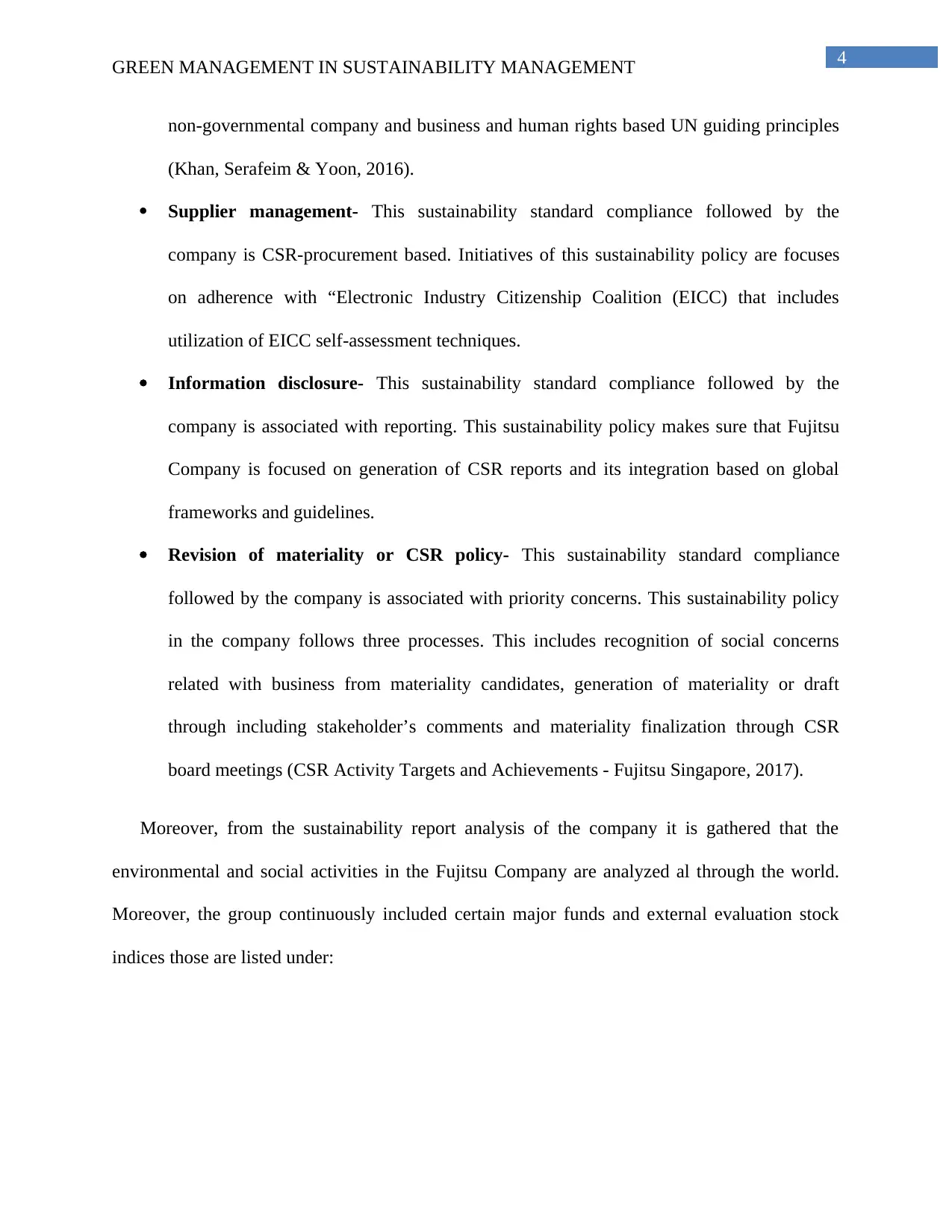
4
GREEN MANAGEMENT IN SUSTAINABILITY MANAGEMENT
non-governmental company and business and human rights based UN guiding principles
(Khan, Serafeim & Yoon, 2016).
Supplier management- This sustainability standard compliance followed by the
company is CSR-procurement based. Initiatives of this sustainability policy are focuses
on adherence with “Electronic Industry Citizenship Coalition (EICC) that includes
utilization of EICC self-assessment techniques.
Information disclosure- This sustainability standard compliance followed by the
company is associated with reporting. This sustainability policy makes sure that Fujitsu
Company is focused on generation of CSR reports and its integration based on global
frameworks and guidelines.
Revision of materiality or CSR policy- This sustainability standard compliance
followed by the company is associated with priority concerns. This sustainability policy
in the company follows three processes. This includes recognition of social concerns
related with business from materiality candidates, generation of materiality or draft
through including stakeholder’s comments and materiality finalization through CSR
board meetings (CSR Activity Targets and Achievements - Fujitsu Singapore, 2017).
Moreover, from the sustainability report analysis of the company it is gathered that the
environmental and social activities in the Fujitsu Company are analyzed al through the world.
Moreover, the group continuously included certain major funds and external evaluation stock
indices those are listed under:
GREEN MANAGEMENT IN SUSTAINABILITY MANAGEMENT
non-governmental company and business and human rights based UN guiding principles
(Khan, Serafeim & Yoon, 2016).
Supplier management- This sustainability standard compliance followed by the
company is CSR-procurement based. Initiatives of this sustainability policy are focuses
on adherence with “Electronic Industry Citizenship Coalition (EICC) that includes
utilization of EICC self-assessment techniques.
Information disclosure- This sustainability standard compliance followed by the
company is associated with reporting. This sustainability policy makes sure that Fujitsu
Company is focused on generation of CSR reports and its integration based on global
frameworks and guidelines.
Revision of materiality or CSR policy- This sustainability standard compliance
followed by the company is associated with priority concerns. This sustainability policy
in the company follows three processes. This includes recognition of social concerns
related with business from materiality candidates, generation of materiality or draft
through including stakeholder’s comments and materiality finalization through CSR
board meetings (CSR Activity Targets and Achievements - Fujitsu Singapore, 2017).
Moreover, from the sustainability report analysis of the company it is gathered that the
environmental and social activities in the Fujitsu Company are analyzed al through the world.
Moreover, the group continuously included certain major funds and external evaluation stock
indices those are listed under:
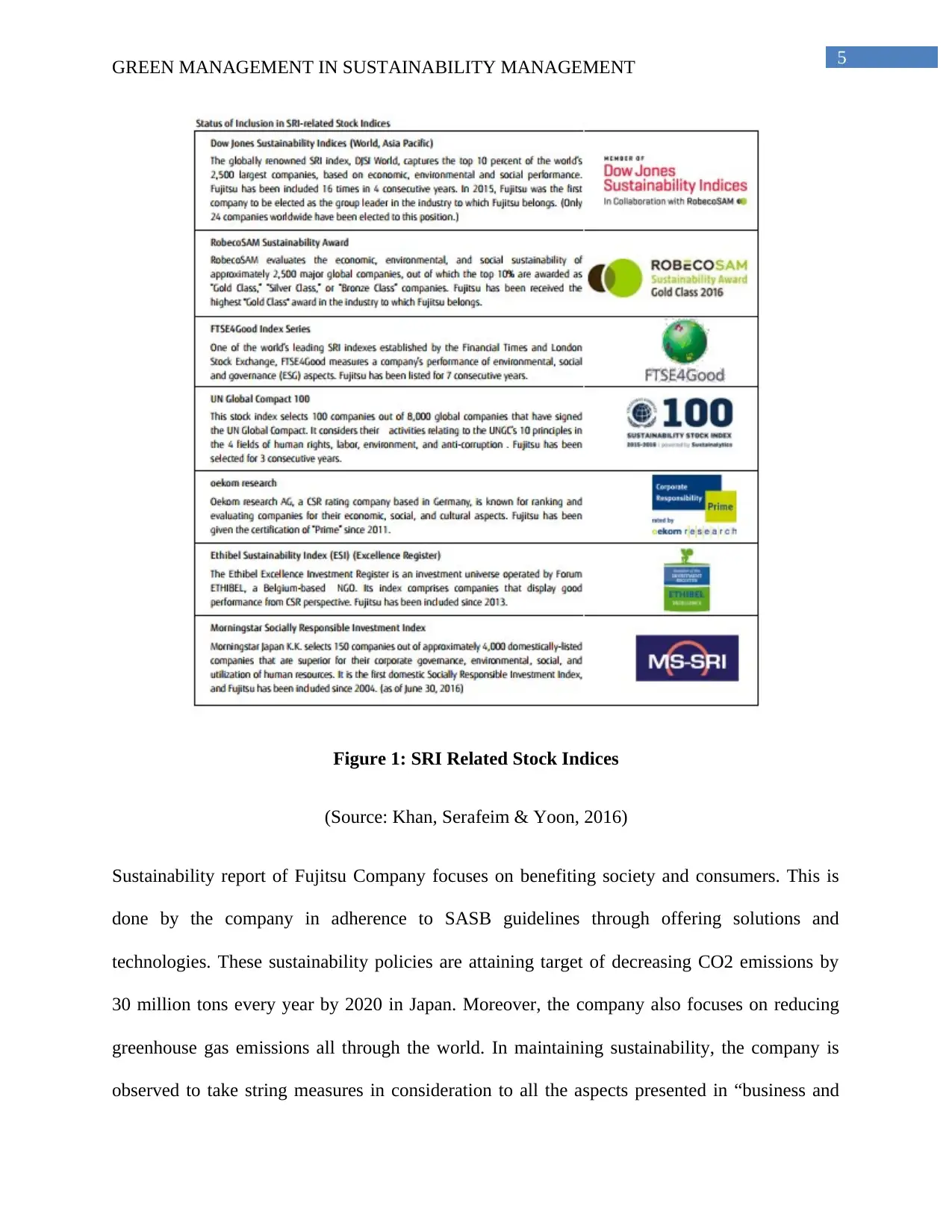
5
GREEN MANAGEMENT IN SUSTAINABILITY MANAGEMENT
Figure 1: SRI Related Stock Indices
(Source: Khan, Serafeim & Yoon, 2016)
Sustainability report of Fujitsu Company focuses on benefiting society and consumers. This is
done by the company in adherence to SASB guidelines through offering solutions and
technologies. These sustainability policies are attaining target of decreasing CO2 emissions by
30 million tons every year by 2020 in Japan. Moreover, the company also focuses on reducing
greenhouse gas emissions all through the world. In maintaining sustainability, the company is
observed to take string measures in consideration to all the aspects presented in “business and
GREEN MANAGEMENT IN SUSTAINABILITY MANAGEMENT
Figure 1: SRI Related Stock Indices
(Source: Khan, Serafeim & Yoon, 2016)
Sustainability report of Fujitsu Company focuses on benefiting society and consumers. This is
done by the company in adherence to SASB guidelines through offering solutions and
technologies. These sustainability policies are attaining target of decreasing CO2 emissions by
30 million tons every year by 2020 in Japan. Moreover, the company also focuses on reducing
greenhouse gas emissions all through the world. In maintaining sustainability, the company is
observed to take string measures in consideration to all the aspects presented in “business and
⊘ This is a preview!⊘
Do you want full access?
Subscribe today to unlock all pages.

Trusted by 1+ million students worldwide
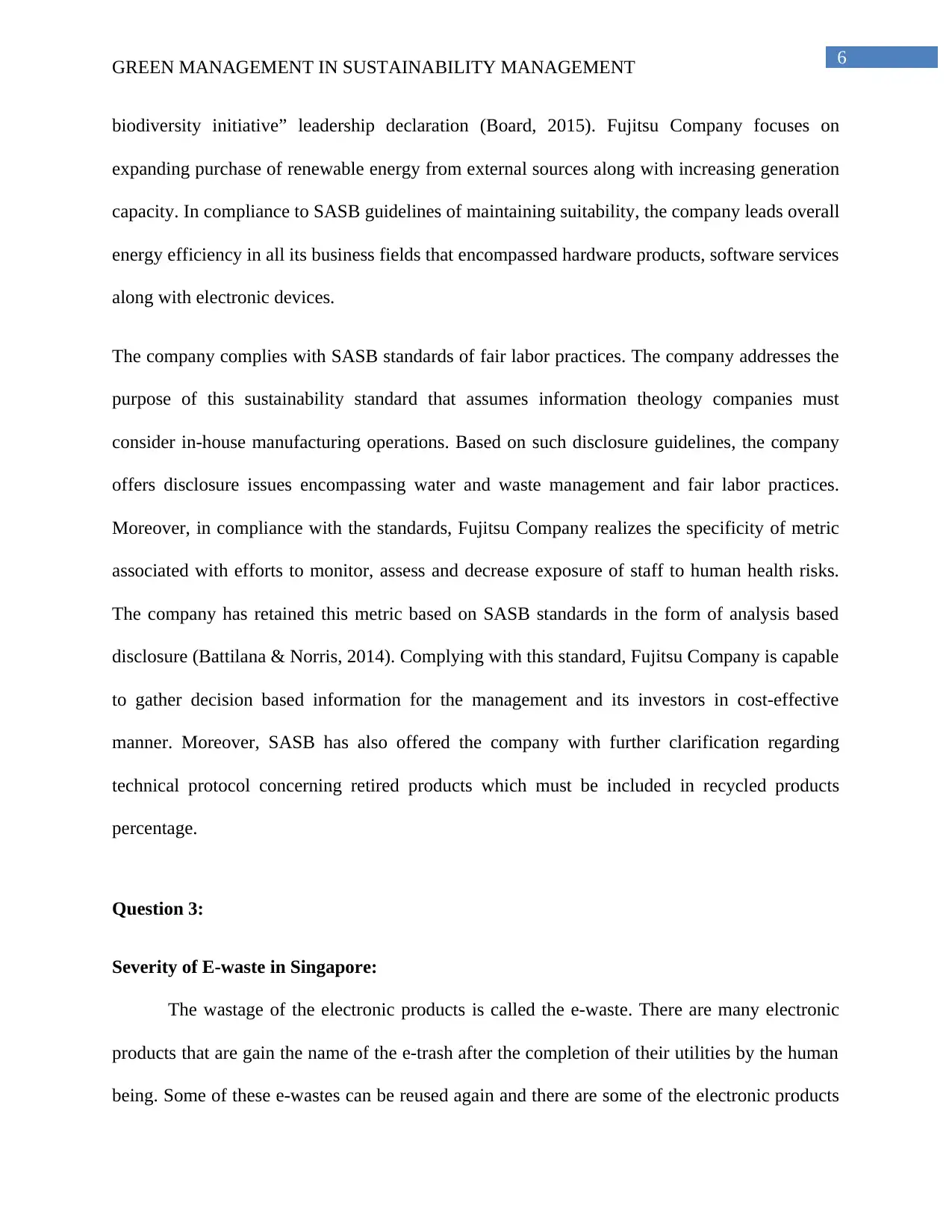
6
GREEN MANAGEMENT IN SUSTAINABILITY MANAGEMENT
biodiversity initiative” leadership declaration (Board, 2015). Fujitsu Company focuses on
expanding purchase of renewable energy from external sources along with increasing generation
capacity. In compliance to SASB guidelines of maintaining suitability, the company leads overall
energy efficiency in all its business fields that encompassed hardware products, software services
along with electronic devices.
The company complies with SASB standards of fair labor practices. The company addresses the
purpose of this sustainability standard that assumes information theology companies must
consider in-house manufacturing operations. Based on such disclosure guidelines, the company
offers disclosure issues encompassing water and waste management and fair labor practices.
Moreover, in compliance with the standards, Fujitsu Company realizes the specificity of metric
associated with efforts to monitor, assess and decrease exposure of staff to human health risks.
The company has retained this metric based on SASB standards in the form of analysis based
disclosure (Battilana & Norris, 2014). Complying with this standard, Fujitsu Company is capable
to gather decision based information for the management and its investors in cost-effective
manner. Moreover, SASB has also offered the company with further clarification regarding
technical protocol concerning retired products which must be included in recycled products
percentage.
Question 3:
Severity of E-waste in Singapore:
The wastage of the electronic products is called the e-waste. There are many electronic
products that are gain the name of the e-trash after the completion of their utilities by the human
being. Some of these e-wastes can be reused again and there are some of the electronic products
GREEN MANAGEMENT IN SUSTAINABILITY MANAGEMENT
biodiversity initiative” leadership declaration (Board, 2015). Fujitsu Company focuses on
expanding purchase of renewable energy from external sources along with increasing generation
capacity. In compliance to SASB guidelines of maintaining suitability, the company leads overall
energy efficiency in all its business fields that encompassed hardware products, software services
along with electronic devices.
The company complies with SASB standards of fair labor practices. The company addresses the
purpose of this sustainability standard that assumes information theology companies must
consider in-house manufacturing operations. Based on such disclosure guidelines, the company
offers disclosure issues encompassing water and waste management and fair labor practices.
Moreover, in compliance with the standards, Fujitsu Company realizes the specificity of metric
associated with efforts to monitor, assess and decrease exposure of staff to human health risks.
The company has retained this metric based on SASB standards in the form of analysis based
disclosure (Battilana & Norris, 2014). Complying with this standard, Fujitsu Company is capable
to gather decision based information for the management and its investors in cost-effective
manner. Moreover, SASB has also offered the company with further clarification regarding
technical protocol concerning retired products which must be included in recycled products
percentage.
Question 3:
Severity of E-waste in Singapore:
The wastage of the electronic products is called the e-waste. There are many electronic
products that are gain the name of the e-trash after the completion of their utilities by the human
being. Some of these e-wastes can be reused again and there are some of the electronic products
Paraphrase This Document
Need a fresh take? Get an instant paraphrase of this document with our AI Paraphraser
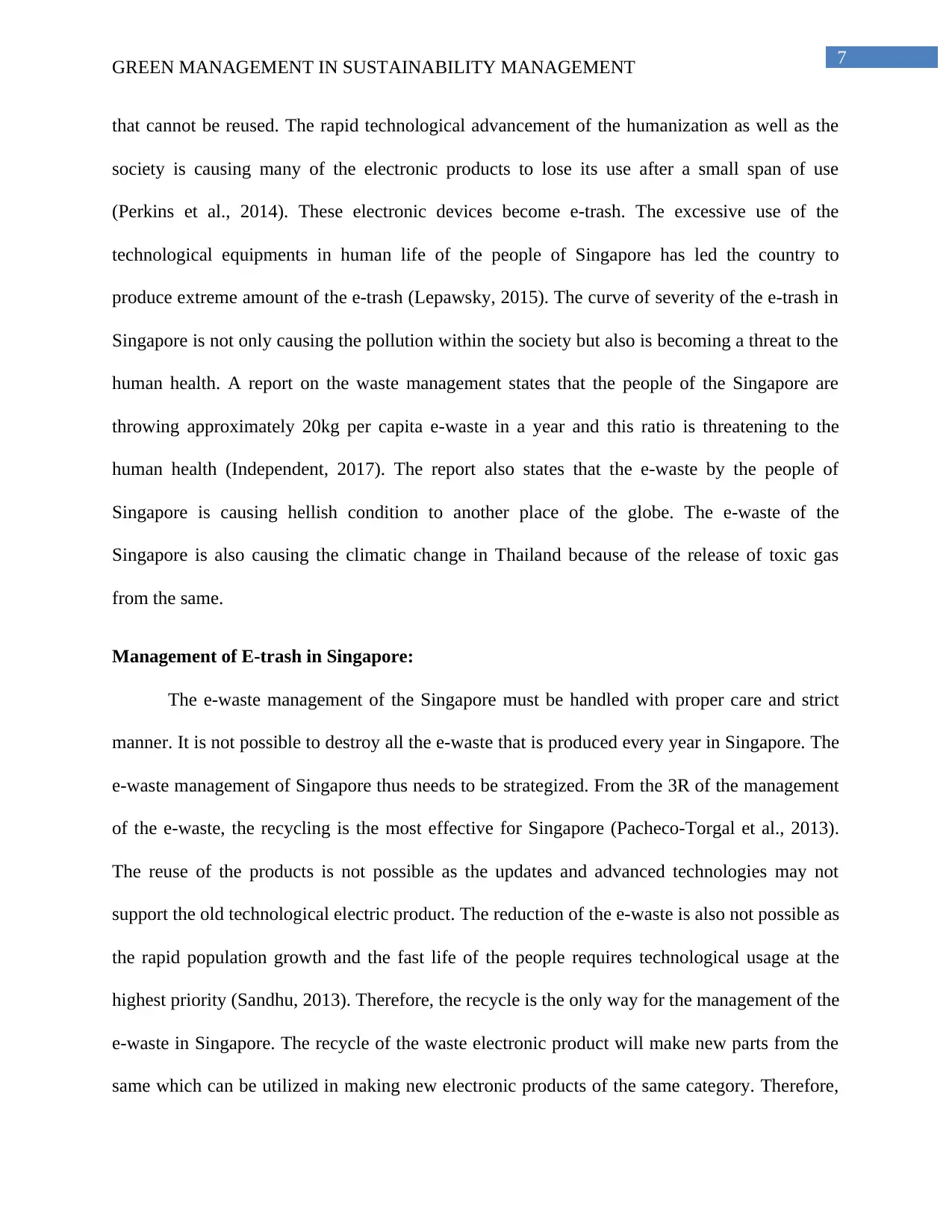
7
GREEN MANAGEMENT IN SUSTAINABILITY MANAGEMENT
that cannot be reused. The rapid technological advancement of the humanization as well as the
society is causing many of the electronic products to lose its use after a small span of use
(Perkins et al., 2014). These electronic devices become e-trash. The excessive use of the
technological equipments in human life of the people of Singapore has led the country to
produce extreme amount of the e-trash (Lepawsky, 2015). The curve of severity of the e-trash in
Singapore is not only causing the pollution within the society but also is becoming a threat to the
human health. A report on the waste management states that the people of the Singapore are
throwing approximately 20kg per capita e-waste in a year and this ratio is threatening to the
human health (Independent, 2017). The report also states that the e-waste by the people of
Singapore is causing hellish condition to another place of the globe. The e-waste of the
Singapore is also causing the climatic change in Thailand because of the release of toxic gas
from the same.
Management of E-trash in Singapore:
The e-waste management of the Singapore must be handled with proper care and strict
manner. It is not possible to destroy all the e-waste that is produced every year in Singapore. The
e-waste management of Singapore thus needs to be strategized. From the 3R of the management
of the e-waste, the recycling is the most effective for Singapore (Pacheco-Torgal et al., 2013).
The reuse of the products is not possible as the updates and advanced technologies may not
support the old technological electric product. The reduction of the e-waste is also not possible as
the rapid population growth and the fast life of the people requires technological usage at the
highest priority (Sandhu, 2013). Therefore, the recycle is the only way for the management of the
e-waste in Singapore. The recycle of the waste electronic product will make new parts from the
same which can be utilized in making new electronic products of the same category. Therefore,
GREEN MANAGEMENT IN SUSTAINABILITY MANAGEMENT
that cannot be reused. The rapid technological advancement of the humanization as well as the
society is causing many of the electronic products to lose its use after a small span of use
(Perkins et al., 2014). These electronic devices become e-trash. The excessive use of the
technological equipments in human life of the people of Singapore has led the country to
produce extreme amount of the e-trash (Lepawsky, 2015). The curve of severity of the e-trash in
Singapore is not only causing the pollution within the society but also is becoming a threat to the
human health. A report on the waste management states that the people of the Singapore are
throwing approximately 20kg per capita e-waste in a year and this ratio is threatening to the
human health (Independent, 2017). The report also states that the e-waste by the people of
Singapore is causing hellish condition to another place of the globe. The e-waste of the
Singapore is also causing the climatic change in Thailand because of the release of toxic gas
from the same.
Management of E-trash in Singapore:
The e-waste management of the Singapore must be handled with proper care and strict
manner. It is not possible to destroy all the e-waste that is produced every year in Singapore. The
e-waste management of Singapore thus needs to be strategized. From the 3R of the management
of the e-waste, the recycling is the most effective for Singapore (Pacheco-Torgal et al., 2013).
The reuse of the products is not possible as the updates and advanced technologies may not
support the old technological electric product. The reduction of the e-waste is also not possible as
the rapid population growth and the fast life of the people requires technological usage at the
highest priority (Sandhu, 2013). Therefore, the recycle is the only way for the management of the
e-waste in Singapore. The recycle of the waste electronic product will make new parts from the
same which can be utilized in making new electronic products of the same category. Therefore,
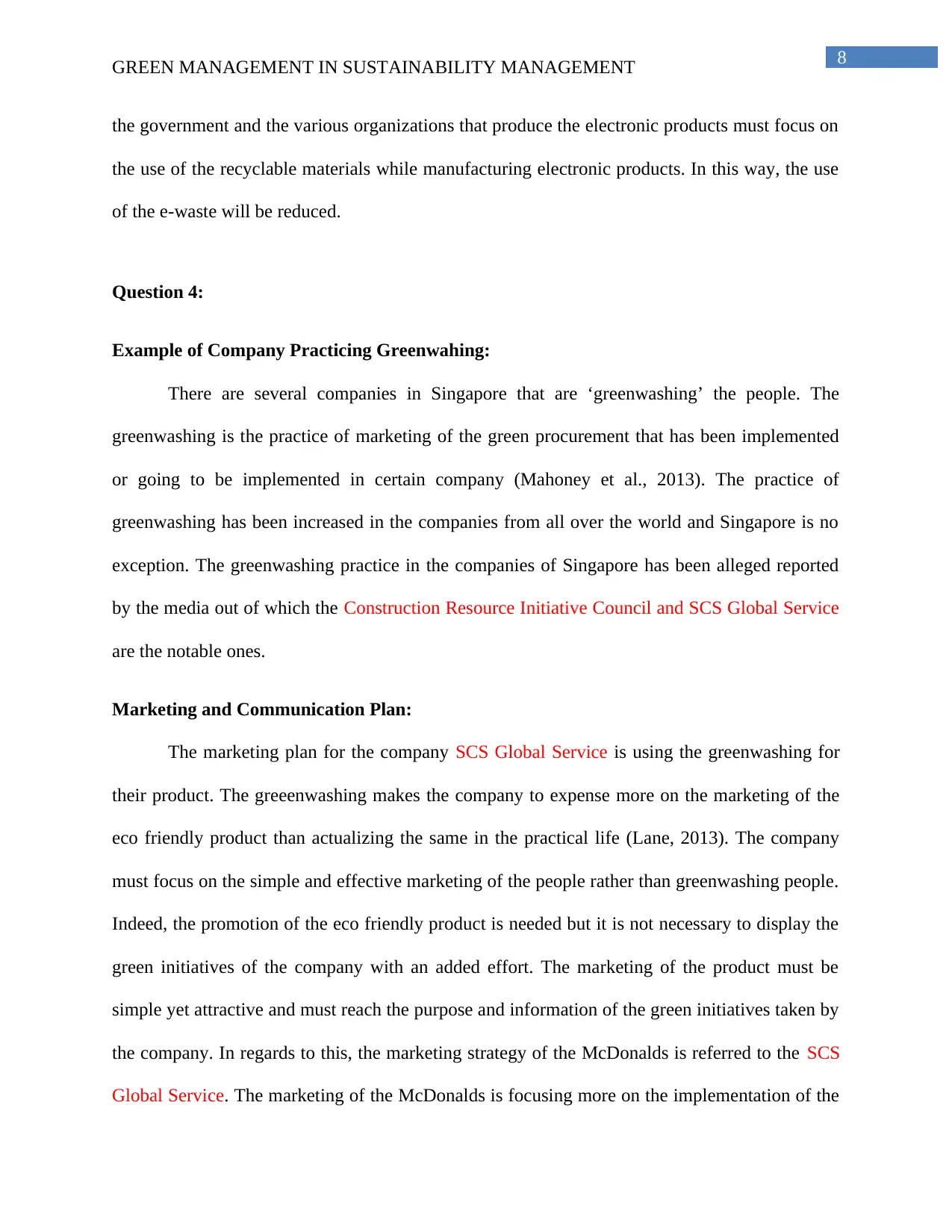
8
GREEN MANAGEMENT IN SUSTAINABILITY MANAGEMENT
the government and the various organizations that produce the electronic products must focus on
the use of the recyclable materials while manufacturing electronic products. In this way, the use
of the e-waste will be reduced.
Question 4:
Example of Company Practicing Greenwahing:
There are several companies in Singapore that are ‘greenwashing’ the people. The
greenwashing is the practice of marketing of the green procurement that has been implemented
or going to be implemented in certain company (Mahoney et al., 2013). The practice of
greenwashing has been increased in the companies from all over the world and Singapore is no
exception. The greenwashing practice in the companies of Singapore has been alleged reported
by the media out of which the Construction Resource Initiative Council and SCS Global Service
are the notable ones.
Marketing and Communication Plan:
The marketing plan for the company SCS Global Service is using the greenwashing for
their product. The greeenwashing makes the company to expense more on the marketing of the
eco friendly product than actualizing the same in the practical life (Lane, 2013). The company
must focus on the simple and effective marketing of the people rather than greenwashing people.
Indeed, the promotion of the eco friendly product is needed but it is not necessary to display the
green initiatives of the company with an added effort. The marketing of the product must be
simple yet attractive and must reach the purpose and information of the green initiatives taken by
the company. In regards to this, the marketing strategy of the McDonalds is referred to the SCS
Global Service. The marketing of the McDonalds is focusing more on the implementation of the
GREEN MANAGEMENT IN SUSTAINABILITY MANAGEMENT
the government and the various organizations that produce the electronic products must focus on
the use of the recyclable materials while manufacturing electronic products. In this way, the use
of the e-waste will be reduced.
Question 4:
Example of Company Practicing Greenwahing:
There are several companies in Singapore that are ‘greenwashing’ the people. The
greenwashing is the practice of marketing of the green procurement that has been implemented
or going to be implemented in certain company (Mahoney et al., 2013). The practice of
greenwashing has been increased in the companies from all over the world and Singapore is no
exception. The greenwashing practice in the companies of Singapore has been alleged reported
by the media out of which the Construction Resource Initiative Council and SCS Global Service
are the notable ones.
Marketing and Communication Plan:
The marketing plan for the company SCS Global Service is using the greenwashing for
their product. The greeenwashing makes the company to expense more on the marketing of the
eco friendly product than actualizing the same in the practical life (Lane, 2013). The company
must focus on the simple and effective marketing of the people rather than greenwashing people.
Indeed, the promotion of the eco friendly product is needed but it is not necessary to display the
green initiatives of the company with an added effort. The marketing of the product must be
simple yet attractive and must reach the purpose and information of the green initiatives taken by
the company. In regards to this, the marketing strategy of the McDonalds is referred to the SCS
Global Service. The marketing of the McDonalds is focusing more on the implementation of the
⊘ This is a preview!⊘
Do you want full access?
Subscribe today to unlock all pages.

Trusted by 1+ million students worldwide
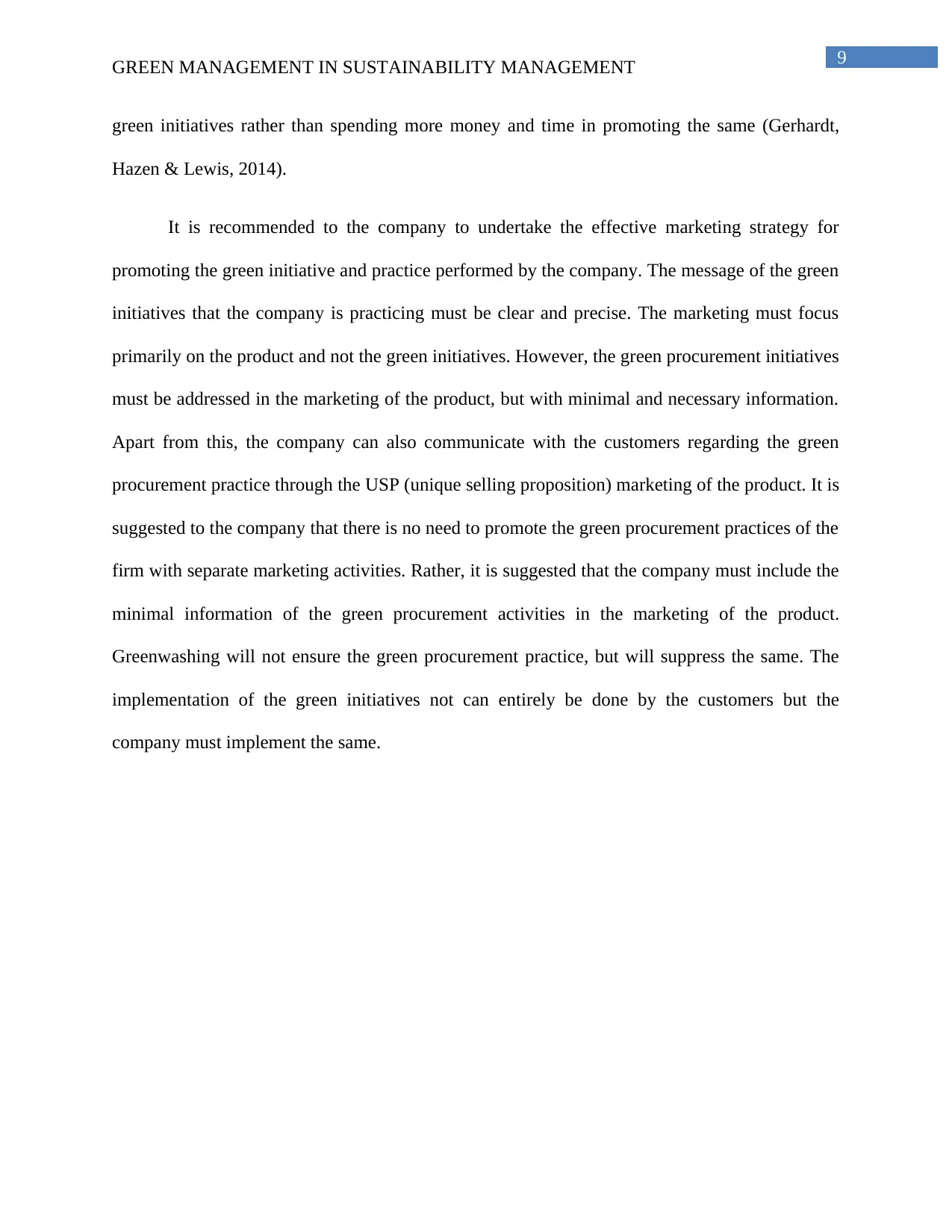
9
GREEN MANAGEMENT IN SUSTAINABILITY MANAGEMENT
green initiatives rather than spending more money and time in promoting the same (Gerhardt,
Hazen & Lewis, 2014).
It is recommended to the company to undertake the effective marketing strategy for
promoting the green initiative and practice performed by the company. The message of the green
initiatives that the company is practicing must be clear and precise. The marketing must focus
primarily on the product and not the green initiatives. However, the green procurement initiatives
must be addressed in the marketing of the product, but with minimal and necessary information.
Apart from this, the company can also communicate with the customers regarding the green
procurement practice through the USP (unique selling proposition) marketing of the product. It is
suggested to the company that there is no need to promote the green procurement practices of the
firm with separate marketing activities. Rather, it is suggested that the company must include the
minimal information of the green procurement activities in the marketing of the product.
Greenwashing will not ensure the green procurement practice, but will suppress the same. The
implementation of the green initiatives not can entirely be done by the customers but the
company must implement the same.
GREEN MANAGEMENT IN SUSTAINABILITY MANAGEMENT
green initiatives rather than spending more money and time in promoting the same (Gerhardt,
Hazen & Lewis, 2014).
It is recommended to the company to undertake the effective marketing strategy for
promoting the green initiative and practice performed by the company. The message of the green
initiatives that the company is practicing must be clear and precise. The marketing must focus
primarily on the product and not the green initiatives. However, the green procurement initiatives
must be addressed in the marketing of the product, but with minimal and necessary information.
Apart from this, the company can also communicate with the customers regarding the green
procurement practice through the USP (unique selling proposition) marketing of the product. It is
suggested to the company that there is no need to promote the green procurement practices of the
firm with separate marketing activities. Rather, it is suggested that the company must include the
minimal information of the green procurement activities in the marketing of the product.
Greenwashing will not ensure the green procurement practice, but will suppress the same. The
implementation of the green initiatives not can entirely be done by the customers but the
company must implement the same.
Paraphrase This Document
Need a fresh take? Get an instant paraphrase of this document with our AI Paraphraser
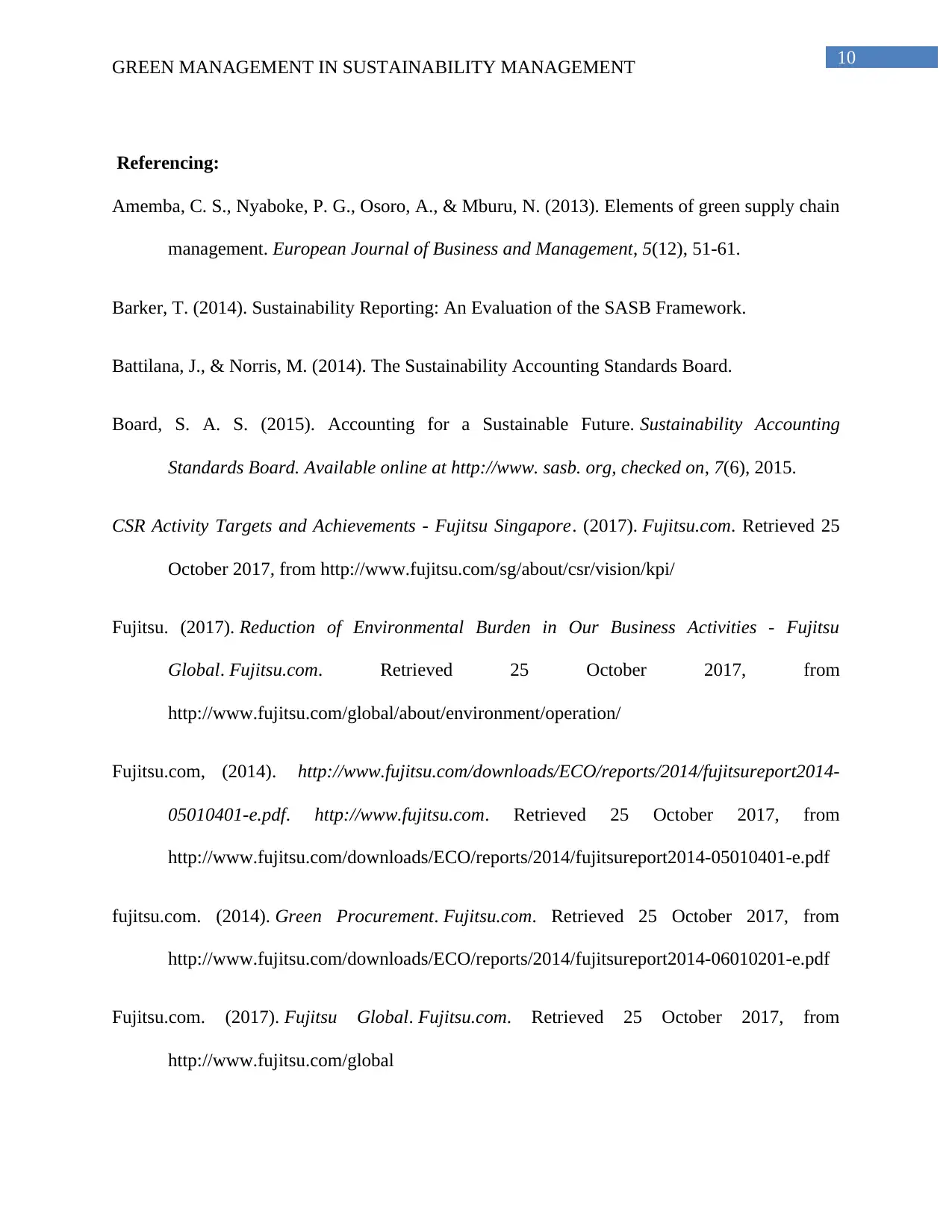
10
GREEN MANAGEMENT IN SUSTAINABILITY MANAGEMENT
Referencing:
Amemba, C. S., Nyaboke, P. G., Osoro, A., & Mburu, N. (2013). Elements of green supply chain
management. European Journal of Business and Management, 5(12), 51-61.
Barker, T. (2014). Sustainability Reporting: An Evaluation of the SASB Framework.
Battilana, J., & Norris, M. (2014). The Sustainability Accounting Standards Board.
Board, S. A. S. (2015). Accounting for a Sustainable Future. Sustainability Accounting
Standards Board. Available online at http://www. sasb. org, checked on, 7(6), 2015.
CSR Activity Targets and Achievements - Fujitsu Singapore. (2017). Fujitsu.com. Retrieved 25
October 2017, from http://www.fujitsu.com/sg/about/csr/vision/kpi/
Fujitsu. (2017). Reduction of Environmental Burden in Our Business Activities - Fujitsu
Global. Fujitsu.com. Retrieved 25 October 2017, from
http://www.fujitsu.com/global/about/environment/operation/
Fujitsu.com, (2014). http://www.fujitsu.com/downloads/ECO/reports/2014/fujitsureport2014-
05010401-e.pdf. http://www.fujitsu.com. Retrieved 25 October 2017, from
http://www.fujitsu.com/downloads/ECO/reports/2014/fujitsureport2014-05010401-e.pdf
fujitsu.com. (2014). Green Procurement. Fujitsu.com. Retrieved 25 October 2017, from
http://www.fujitsu.com/downloads/ECO/reports/2014/fujitsureport2014-06010201-e.pdf
Fujitsu.com. (2017). Fujitsu Global. Fujitsu.com. Retrieved 25 October 2017, from
http://www.fujitsu.com/global
GREEN MANAGEMENT IN SUSTAINABILITY MANAGEMENT
Referencing:
Amemba, C. S., Nyaboke, P. G., Osoro, A., & Mburu, N. (2013). Elements of green supply chain
management. European Journal of Business and Management, 5(12), 51-61.
Barker, T. (2014). Sustainability Reporting: An Evaluation of the SASB Framework.
Battilana, J., & Norris, M. (2014). The Sustainability Accounting Standards Board.
Board, S. A. S. (2015). Accounting for a Sustainable Future. Sustainability Accounting
Standards Board. Available online at http://www. sasb. org, checked on, 7(6), 2015.
CSR Activity Targets and Achievements - Fujitsu Singapore. (2017). Fujitsu.com. Retrieved 25
October 2017, from http://www.fujitsu.com/sg/about/csr/vision/kpi/
Fujitsu. (2017). Reduction of Environmental Burden in Our Business Activities - Fujitsu
Global. Fujitsu.com. Retrieved 25 October 2017, from
http://www.fujitsu.com/global/about/environment/operation/
Fujitsu.com, (2014). http://www.fujitsu.com/downloads/ECO/reports/2014/fujitsureport2014-
05010401-e.pdf. http://www.fujitsu.com. Retrieved 25 October 2017, from
http://www.fujitsu.com/downloads/ECO/reports/2014/fujitsureport2014-05010401-e.pdf
fujitsu.com. (2014). Green Procurement. Fujitsu.com. Retrieved 25 October 2017, from
http://www.fujitsu.com/downloads/ECO/reports/2014/fujitsureport2014-06010201-e.pdf
Fujitsu.com. (2017). Fujitsu Global. Fujitsu.com. Retrieved 25 October 2017, from
http://www.fujitsu.com/global
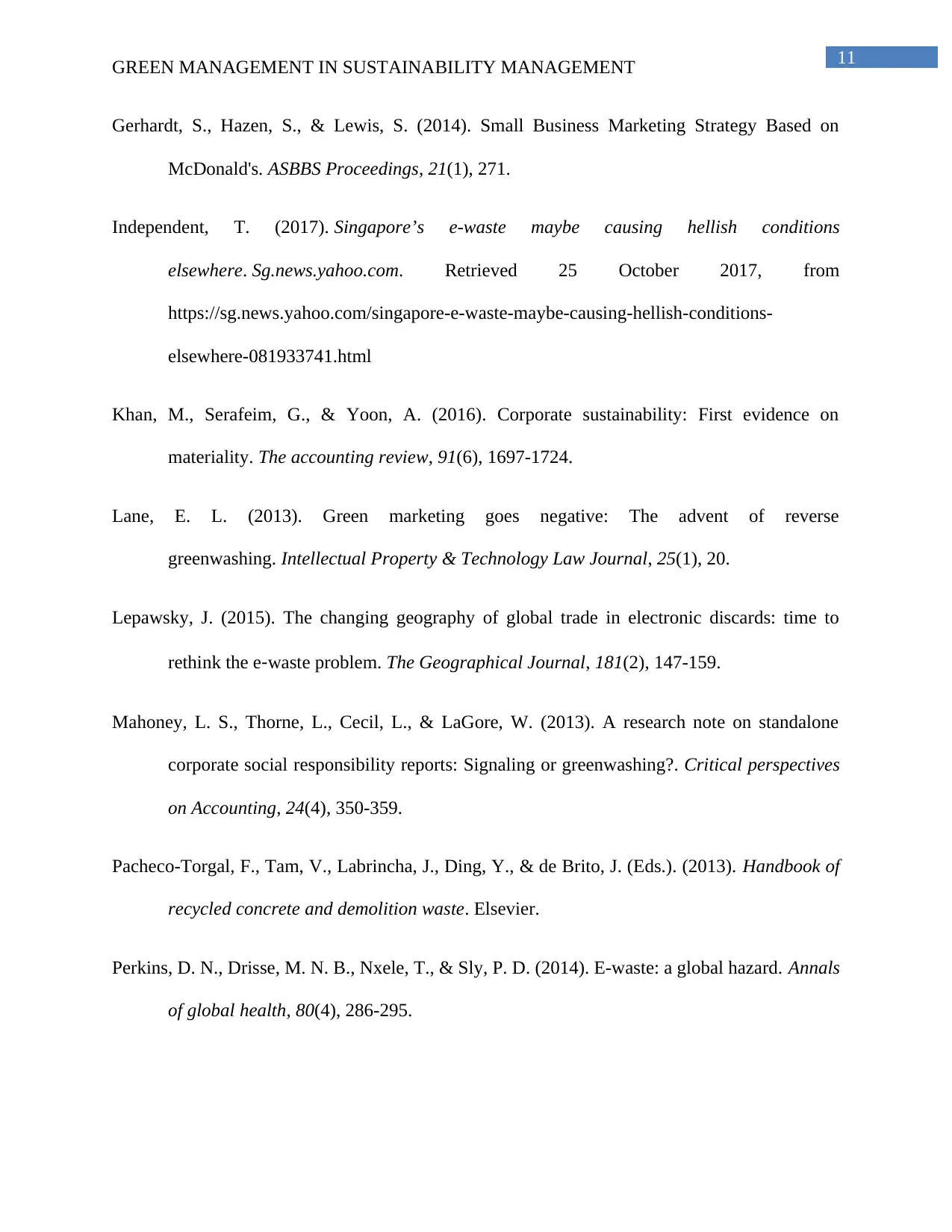
11
GREEN MANAGEMENT IN SUSTAINABILITY MANAGEMENT
Gerhardt, S., Hazen, S., & Lewis, S. (2014). Small Business Marketing Strategy Based on
McDonald's. ASBBS Proceedings, 21(1), 271.
Independent, T. (2017). Singapore’s e-waste maybe causing hellish conditions
elsewhere. Sg.news.yahoo.com. Retrieved 25 October 2017, from
https://sg.news.yahoo.com/singapore-e-waste-maybe-causing-hellish-conditions-
elsewhere-081933741.html
Khan, M., Serafeim, G., & Yoon, A. (2016). Corporate sustainability: First evidence on
materiality. The accounting review, 91(6), 1697-1724.
Lane, E. L. (2013). Green marketing goes negative: The advent of reverse
greenwashing. Intellectual Property & Technology Law Journal, 25(1), 20.
Lepawsky, J. (2015). The changing geography of global trade in electronic discards: time to
rethink the e‐waste problem. The Geographical Journal, 181(2), 147-159.
Mahoney, L. S., Thorne, L., Cecil, L., & LaGore, W. (2013). A research note on standalone
corporate social responsibility reports: Signaling or greenwashing?. Critical perspectives
on Accounting, 24(4), 350-359.
Pacheco-Torgal, F., Tam, V., Labrincha, J., Ding, Y., & de Brito, J. (Eds.). (2013). Handbook of
recycled concrete and demolition waste. Elsevier.
Perkins, D. N., Drisse, M. N. B., Nxele, T., & Sly, P. D. (2014). E-waste: a global hazard. Annals
of global health, 80(4), 286-295.
GREEN MANAGEMENT IN SUSTAINABILITY MANAGEMENT
Gerhardt, S., Hazen, S., & Lewis, S. (2014). Small Business Marketing Strategy Based on
McDonald's. ASBBS Proceedings, 21(1), 271.
Independent, T. (2017). Singapore’s e-waste maybe causing hellish conditions
elsewhere. Sg.news.yahoo.com. Retrieved 25 October 2017, from
https://sg.news.yahoo.com/singapore-e-waste-maybe-causing-hellish-conditions-
elsewhere-081933741.html
Khan, M., Serafeim, G., & Yoon, A. (2016). Corporate sustainability: First evidence on
materiality. The accounting review, 91(6), 1697-1724.
Lane, E. L. (2013). Green marketing goes negative: The advent of reverse
greenwashing. Intellectual Property & Technology Law Journal, 25(1), 20.
Lepawsky, J. (2015). The changing geography of global trade in electronic discards: time to
rethink the e‐waste problem. The Geographical Journal, 181(2), 147-159.
Mahoney, L. S., Thorne, L., Cecil, L., & LaGore, W. (2013). A research note on standalone
corporate social responsibility reports: Signaling or greenwashing?. Critical perspectives
on Accounting, 24(4), 350-359.
Pacheco-Torgal, F., Tam, V., Labrincha, J., Ding, Y., & de Brito, J. (Eds.). (2013). Handbook of
recycled concrete and demolition waste. Elsevier.
Perkins, D. N., Drisse, M. N. B., Nxele, T., & Sly, P. D. (2014). E-waste: a global hazard. Annals
of global health, 80(4), 286-295.
⊘ This is a preview!⊘
Do you want full access?
Subscribe today to unlock all pages.

Trusted by 1+ million students worldwide
1 out of 12
Related Documents
Your All-in-One AI-Powered Toolkit for Academic Success.
+13062052269
info@desklib.com
Available 24*7 on WhatsApp / Email
![[object Object]](/_next/static/media/star-bottom.7253800d.svg)
Unlock your academic potential
Copyright © 2020–2025 A2Z Services. All Rights Reserved. Developed and managed by ZUCOL.




